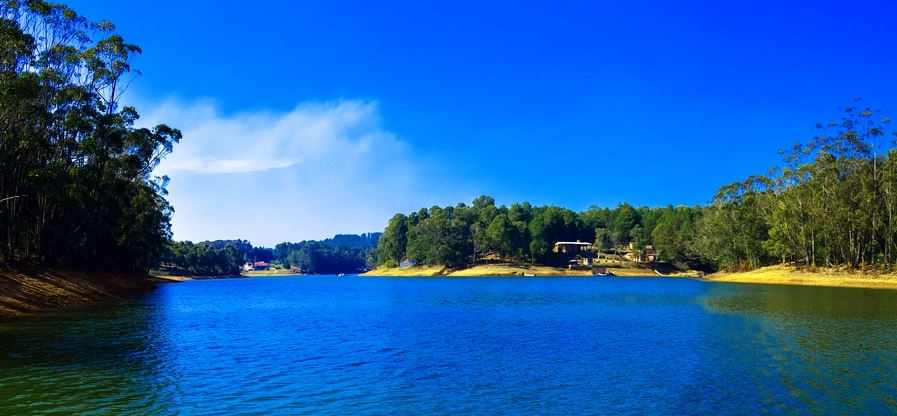Mantasoa, which in Malagasy language means “is pleasant even raw” locates himself from 70 kilometers in the North-East of Antananarivo the Malagasy capital. It is easily accessible by highway N°2
As the majority of the geographical sets which forms the “Great Island”, the central highlands as well offer examples of wonderful places which are worth a visit. Among the enchanting places of this part of Madagascar, one must absolutely count Mantasoa situated at the extreme eastern side of the highlands. It is the door of entrance of the Eastern area with the Angavo large escarpment located not far from this charming destination. Those who are in search of the authentic very serene back corner landscapes of the 19th century will be rewarded by taking the destination of Mantasoa. This one presents relics of the industrial facility of this time. It is difficult to resist the charms of landscape assembled of any part by Jean Laborde.
Mantasoa, which in Malagasy language means “is pleasant even raw” locates himself from 70 kilometers in the North-East of Antananarivo the Malagasy capital. It is easily accessible by highway N°2 which leads to the largest city port of Tamatave or Toamasina on the east coast. This site is ideal for retreat and a holiday in the middle of large pine forests which gives tranquility. It is very popular for the Antananarivo city dwellers and it also constitutes a crossing point of tourists who join the East coast of Madagascar. Three principal attractions of this place are the artificial lake of Mantasoa, the industrial city which Jean Laborde built himself and his tomb: Soamandrakizay. To know better about Mantasoa, it is essential initially know the father of all these wonders. Initially, Jean Laborde was a French adventurer, trader and entrepreneur. He was the first French Consul placed by Napoleon III in the Great Island in order to counteract the English ambition to obtain Madagascar, in other words it has the role of installing the French influence in the Great Island. It had a considerable influence on the central highlands social life and the political life of the Merina kingdom of the 19th century. Appreciated by the Queen Ranavalona the 1st, he became her architect and weapon manufacturer of.
He lived at the same period as the three Ranavalona queens (I, II, III) and the famous Prime Minister Rainilaiarivony. As said earlier “Lake Mantasoa” is an artificial lake. Like almost everywhere in Mantasoa, immense pine forests cover the majority of the land. This lake was born following the construction of a dam which is used to regularize the flow of the Ikopa River. It was built in 1937. The maximum amount of water this lake can contain is 110 million cubic meter. It is the lake which makes all the charm of Mantasoa. It is from its construction that the area acquired its reputation after it received a new face. This lake could remain in this zone because of the presence of small valleys. Its natural aspect and the mark of artificial touch give this lake a real enchantment; it also gave the presence of many curves. This large lake can be the subject of a pleasant boat trips and other nautical activities such as pedal boat and water skiing….
From December to April, the twilight in this place is softened by the melodious songs of cicadas which are very numerous in the pine forest, which in their turn also discharge strong odors.
After having seen the lake, its entourage is in no case negligible with its industrial city. Jean Laborde’s complex industrial city was set up near the lake according to the Malagasy queen Ranavalona the 1st wish. Indeed, Mantasoa was a favorable place because of the abundance of iron, wood and water it had. In the 19th century, this industrial city was a single wonder in its kind in a country like Madagascar.
Historically, this jewel built by Jean Laborde was allocated to the Jesuits at the beginning of the colonization in 1895 in reward of their unerring support in the conquest and the administration of Madagascar. This city composed of an industrial complex is as quite attractive as the lake. While observing the complexity of this monumental structure, the importance of the all the works undertaken to build it will immediately come to mind.
The complex is composed of many factories from the porcelain factory, the manufacturing plant for guns and the blast furnace for foundry. The author of this work also created a certain number of various workshops. The latter were intended to manufacture multiple products, in particular weapons such as guns, rifles, arrows and even the ammunition. The other productions of these workshops are bricks, tiles, soaps, acids, paintings etc…
This circular city of Jean Laborde was dominated in its center by queen Ranavalona summer residence from which only souvenir remains today. Contrary to the residence of the queen, Jean Laborde’s wooden residence was situated on the northern part of the factories. It was the subject of a rebuilding with some of its original materials. Some of Jean Laborde’s works could not resist all the events and disturbs which had shaken the kingdom of Madagascar and which forced him to go into exile to Reunion Island. The relics which currently remain visible are the blast furnace, the furnace of cement, and the ruins of the pottery furnaces, the lime kiln and the foundry workshop. To finish your visit with Mantasoa, it is recommended to visit the tomb of the author of this marvelous monument; a tomb which he had set up himself and which he baptized “Soamandrakizay” or “Eternal Happiness” as a Malagasy. Today, several top-range hotels are built there to provide you a calm visit or a relaxing stay.

